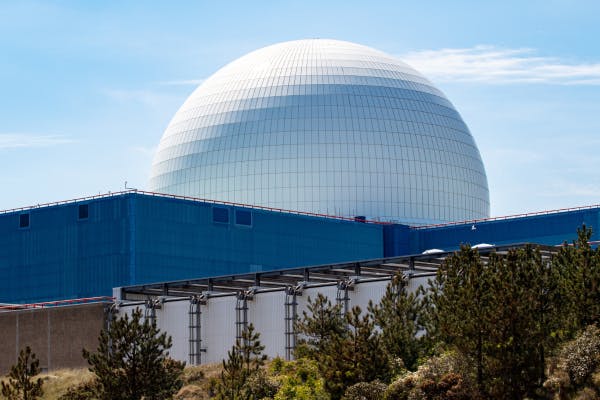Guide: Is nuclear power considered renewable?
Let's take a closer look at the role of nuclear power in our energy generation mix.
Is nuclear power renewable?
The short answer is no, as resources are used up in the generation of electricity.
Nuclear power relies on the fission of uranium or plutonium atoms to generate heat, which is then used to produce steam and generate electricity. While nuclear fuel sources like uranium are relatively abundant, they are not renewable in the sense that they are finite resources on Earth.
Additionally, mining and the processing of the raw materials also has an environmental impact but perhaps the biggest problem with nuclear power is what to do with the radioactive waste that is produced.
So nuclear power isn't the long-term answer to power generation?
This is where it gets more complicated as nuclear power could be considered a low-carbon energy source, given the very low amounts of carbon generated when producing electricity.
And nuclear fusion remains a tantalising prospect to solve future global power requirements.
Nuclear fission or fusion?

Nuclear fission
Currently all Nuclear reactors use fission to create energy. This is where a heavy atom - typically Uranium or Plutonium - absorbs a neutron, making it unstable and ultimately results in 'splitting the atom'.
The unstable nucleus splits into two or more smaller nuclei, releasing additional neutrons and a significant amount of energy, this in turn can kick start further reactions as smaller nuclei and additional neutrons are released and additional fission occurs.
The energy released during the fission process is captured as heat, which is used to produce steam and thus electricity.

Nuclear fusion
This is the process that powers all stars, including the Sun, but so far humanity has been unable to quite get to grips with it. The fusion process sees two light atomic nuclei form a heavier nucleus, generating a huge amount of energy. The Sun converts hydrogen nuclei into helium, thanks to the incredible gravitational forces and heat in the star's core.
In the context of controlled nuclear fusion on Earth, researchers and engineers are working on developing fusion reactors that can harness this energy to produce electricity. The primary fuel for nuclear fusion on Earth is typically isotopes of hydrogen, such as deuterium and tritium.
Here's a breakdown of the nuclear fusion process:
- Fuel: The fusion process typically involves isotopes of hydrogen, with deuterium (an isotope of hydrogen with one proton and one neutron) and tritium (an isotope of hydrogen with one proton and two neutrons) being the most commonly considered fuels due to their abundance and ease of fusion.
- Fusion: Under extremely high temperatures and pressures, the nuclei of the hydrogen isotopes collide and fuse together to form helium, releasing a neutron and a large amount of energy in the form of kinetic energy.
- Energy capture: The energy released during the fusion process is captured as heat, which can then be used to produce steam and drive turbines connected to generators, producing electricity.
The potential advantages of nuclear fusion as an energy source include:
- Abundant fuel supply: Deuterium can be extracted from water, and tritium can be produced from lithium, which are both abundant resources.
- High energy yield: Nuclear fusion has the potential to produce a large amount of energy from a relatively small amount of fuel.
- Reduced radioactive waste: Unlike nuclear fission, which produces long-lived radioactive waste, nuclear fusion produces only short-lived radioactive waste.
Despite the promising potential of nuclear fusion, it remains a challenging technology to develop and commercialise due to the extreme conditions required to initiate and sustain the nuclear fusion reaction, as well as the technical and engineering challenges associated with containing and controlling the plasma at such high temperatures and pressures.
However, the promise of nuclear fusion is such that the development of the technology continues at pace.
Radioactive waste
According to the World Nuclear Association, over 90 per cent of the waste created by nuclear technologies is successfully managed around the world using widely agreed disposal practices. However, storage and disposal is a costly and long-term activity with deep geological disposal now one of the most widely accepted forms of disposal, which simplistically means burying the waste deep underground in a way that doesn't allow any of the material to escape.
Suitable sites need to be in areas of very low geological activity and ideally with 'natural' protective barriers, such as clay or salt beds.
A part to play in the energy generation mix?
Some countries, notably USA and France, put great store in the dependable and long term energy nuclear power stations provide. In the United States alone 92 reactors are providing enough energy to cater for 20 per cent of the country's energy needs. While in France, they're even more dependent on Nuclear, with around 70 per cent of French energy provided by Nuclear, from 56 reactors.
Comparatively, the UK is far behind with around 15 per cent generated by Nuclear power from five locations and only one additional reactor currently being built - Hinkley Point C in Somerset, and not due to be operational until 2030. While over in Germany, the last reactor was switched off in April 2023, with safety given as the reason for the country moving away from Nuclear.
Energy generation across the globe is a complex business, with no one technology offering a definitive solution, we're likely to see Nuclear fission being used for generations to come.
The pros and cons of nuclear power generation
-
Long term, dependable electricity
-
Very high development and construction costs
-
Low carbon energy - operationally no GHG is generated
-
Radioactive waste disposal - is a multi-generational and costly activity
-
Energy security - as countries transition away from coal and gas, nuclear is seen as a way for countries to become more self reliant on energy production
-
Development of nuclear fusion power - if all the challenges can be solved, fusion mitigates some of the risk factors of nuclear and doesn't require plutonium or uranium
-
Risk - although huge steps have been made to make nuclear power generation safe, it is still not without risk. Serious accidents are very, very rare but can have dire consequences. Serious accidents have occurred at Three Mile Island, Chernobyl and Fukushima. Threat to life, human or otherwise, is significant both near the location and further afield if radioactive material spreads
-
Non-renewable energy source - although it is low carbon
More guides
6 surprising things you didn’t know about electric vans

Understanding Vehicle Excise Duty (VED) or "Road Tax" for EVs
How to save money on a new car with Salary Sacrifice
